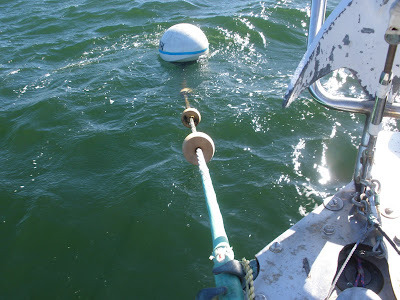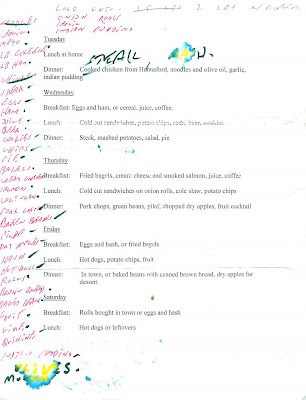Trimming the spinnaker: the pole should be square to the apparent wind, or a little forward of that if it is blowing. Ease the sheet until the windward edge of the spin starts to break. If it blowing over trim the sheet a little, or more than a little if you are running and the wind is piping up.
You want the sail to break on its “shoulder”. If it breaks too high, bring the pole down. Too low, lift the pole. You will find that the closer to the wind you are, the lower you will want the pole. If you are running the pole might be all the way up on its track.
Don’t let the pole push too hard on the
forestay. Keep good tension on the
afterguy to prevent that.
If it is really blowing you can get better control of the chute by running the sheet through a block at the rail a little aft of midships, maybe at the forward end of the jib track. The windier it is, the more you are concerned with "locking" the sail
over the boat. Fine trim becomes much less important. Running in a strong wind you absolutely want the center of effort of the spinnaker over the centerline of the yacht, and that means trimming the sheet hard and easing the afterguy.
That (as well as making sure the halyard is “two blocked”, or all the way up) keeps the sail locked (sort of) over the boat when broad reaching or running. I rarely do this on my Vega but we often used it on
Solings to have good steering control broad reaching or even running in lots of wind. You can do the same thing with the
afterguy to improve the pull angle and also help keep the pole down.
I don't worry much about the after guy chafing on the shroud or not having a good angle to keep the pole back. With good modern low-stretch line you ought to be able to keep the pole off the
forestay well enough, and if it is so windy you can't do that (and you are using nice low stretch line for your spinnaker sheet and guy) it is probably time to ease your course off a little or take in the chute. Big boats use a "reaching strut" rigged on the mast five or so feet off the deck and sticking out 90 deg to the
centerline to a few feet outboard, with the guy running through the outboard end, to improve the
afterguy pull angle.
Jibing: I use the swap pole ends technique. When it is blowing hard that operation really is easier if you run the sheet and guy through those
midship blocks, because if it is windy and you go before the wind to jibe and take the pole off the mast, the chute can really rise up and start bobbling around, not so good and also it makes it hard to grab the "new guy" to snap the pole on. If you use the
midship blocks and maybe
overtrim the sheet a little the chute is still pretty locked in even when the pole is off. But all that's only an issue in I would say at least 18
kts plus. Otherwise just use the quarter blocks.
Here’s how I jibe:
Bear off to a run or very broad reach.
Overtrim the old sheet a little and be ready to trim the new sheet some when the pole comes off it.
Take the pole off the mast and bring the old guy in with the pole. If it is hard to get the pole off the mast ask for a little ease on the guy.
Take the old guy off and snap the other end of the pole into old sheet/new guy.
Jibe the main and trim on the new course.
Steering is key. If you jibe and the helmsman lets the boat up to a reach before the pole is on, the sail will blow into the
foretriangle and make a mess unless helm bears off quickly. In a wind it takes 3 good hands, trimmer, helm and foredeck. Take one out of the equation and it makes for a poor show.
Handing the sail: Like hoisting, in reverse. Get the boat right before the wind, and dump the guy so the sail collapses behind the main. Keep the spinnaker in the lee of the main and one man brings it down while another eases the halyard. Hard for one man to do both and keep the sail out of the water. We put the sail right down the forward hatch and then repack it below.
All this makes flying the chute seem very intimidating. But it is a really useful light weather sail, and sailors have used light sails for centuries and I think all sailors ought to be comfortable with a chute, at least in moderate winds. Like anything else in sailing, take it in bites, increasing your comfort level in stages. But don't practice in a light air: you can't tell what you are doing right or wrong. 7 - 15
kts or so is perfect for practice.
When you are running dead downwind, clew of the chute at the
headstay, pole 90 deg to
centerline so the whole chute is in the wind, main boom all the way out on the other side, and with that great spread of canvas you are making good time in a modest breeze on course and in perfect equanimity, you will feel like a good sailor.
 The spirits locker is in the forward cabin under the bunks, in a rack I built into the boat.
The spirits locker is in the forward cabin under the bunks, in a rack I built into the boat. I generally keep gin, rum and scotch on board. I use Chivas Regal bottles for decanters because they are fat and steady in a seaway, or if the boat rolls at anchor. With limes and some tonic and ice, I can make a great drink, but plain scotch and boat water tastes awfully good too.
I generally keep gin, rum and scotch on board. I use Chivas Regal bottles for decanters because they are fat and steady in a seaway, or if the boat rolls at anchor. With limes and some tonic and ice, I can make a great drink, but plain scotch and boat water tastes awfully good too.











